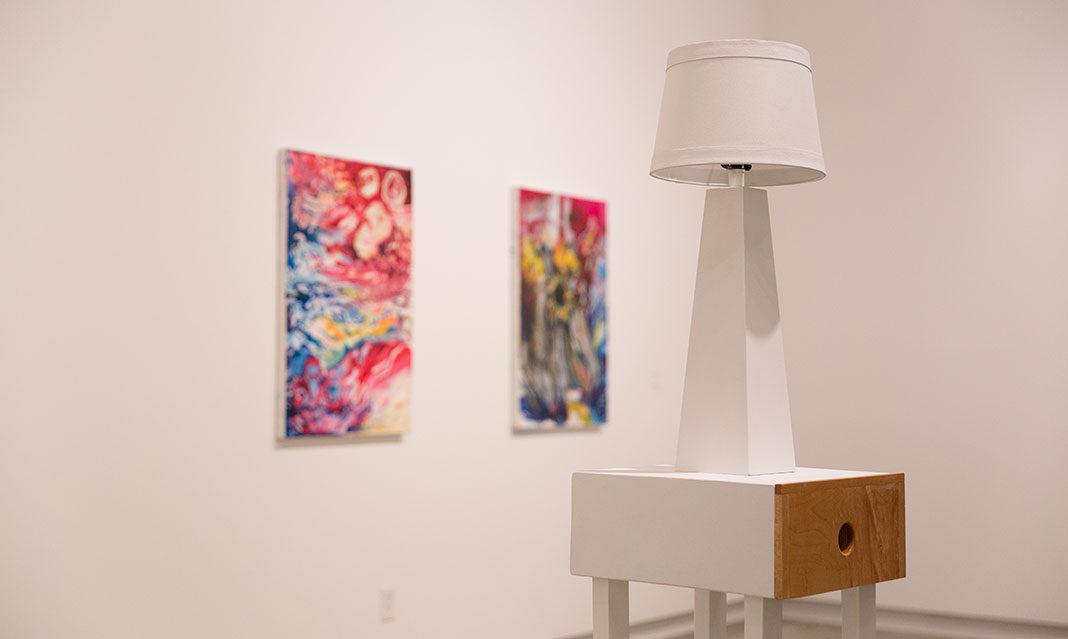As the school year comes to a close, many students will graduate and enter new phases of life, myself included. Although it’s an exciting time, the feeling is bittersweet. Fortunately, graduates of the art and art history program have left behind a piece of their legacy at UTM, if only for a little while. Blackwood Gallery currently showcases Verge, an exhibition featuring artwork by the graduating students.
According to the exhibition statement, the term “verge” refers to a state of transition, or a border waiting to be crossed. Verge therefore acts as a fitting title for this exhibition. The pieces on display confront issues of identity, popular culture, and sexuality, among others. They rely on a diverse blend of mediums, including paint, print, sculpture, and photography.
Verge occupies Blackwood’s main gallery, as well as the e|gallery in CCIT. It consists of two exhibitions. The first segment opened on March 15 and ran until March 25. The second segment opens this coming Wednesday.
While touring the first exhibition, I began at Blackwood’s main studio before moving on to the e|gallery. The room displayed several pieces on each wall, while the floor collected three sculptures. I started with the right wall. I first arrived at Subin Ee’s pair of unnamed mixed media pieces on MDF (medium-density fibreboard). The two boards, both of equal size, contained an abstract fusion of neutral shades. Colours of black, brown, and grey dominated the piece on the left. The colours blurred with each other in an indistinguishable pattern. When I stepped closer, the mixed media components become more apparent. I noticed that certain colours behaved as different layers. The brown, for instance, was a matte, scratchy surface, while the black was reflective and glossy.
The twin piece relied on lighter shades of white and beige, which lightly coated a layer of black scrawls. Each piece possessed a raw and intriguing personality. I always tend to gravitate towards abstract pieces, perhaps because of their openness to interpretation. Ee’s pieces offered a clever blend of mixed mediums that certainly invited individual meaning.
As I travelled to the other side of the room, I experienced a strange attraction to Rebecca Filman’s work, “And Observations May Be Made.” Her collection featured five pieces of screenprint and India ink on paper. The prints depicted obscure imagery from what appeared to be the late 1800s to early 1900s. Some portions appeared in a grainy, black-and-white style, while other, smaller sections were slightly coloured in a dull orange hue.
The prints showed fragments of biological anatomy (some human, some insect), coupled with the antiquity of old technology. Three prints also contained snippets of typed text to accompany the images. My favourite piece portrayed a half-formed image of an old diver’s suit, cast in black-and-white. Inside the helmet, the head was replaced with an ambiguous blob, coloured with the dull orange hue. I enjoyed the simplicity and minimalism of Filman’s pieces, in addition to their antique appearance.
I then walked to CCIT, where the remaining pieces were displayed in the e|gallery. I discovered Mikaela Lima’s “Veiled” tacked to the wall. I first noticed the Plexiglas net. The transparent shards splayed out in the shape of a circle, accompanied by four photographs. The portraits depicted four women, unsmiling, with the Plexiglas net draped over their heads like a veil. When I stepped back, the effect of the photos changed. The net became invisible, and the women’s faces seemed hazy, or clouded over by some unknown substance.
Verge supplied the art and art history graduates with a final farewell. The exhibition offered them a stepping stone into their next chapter, whether they choose to begin their careers or continue their education. Verge shared each student’s journey.
Verge’s second exhibition will open on March 29 and run until April 8 at Blackwood Gallery and UTM’s e|gallery.



